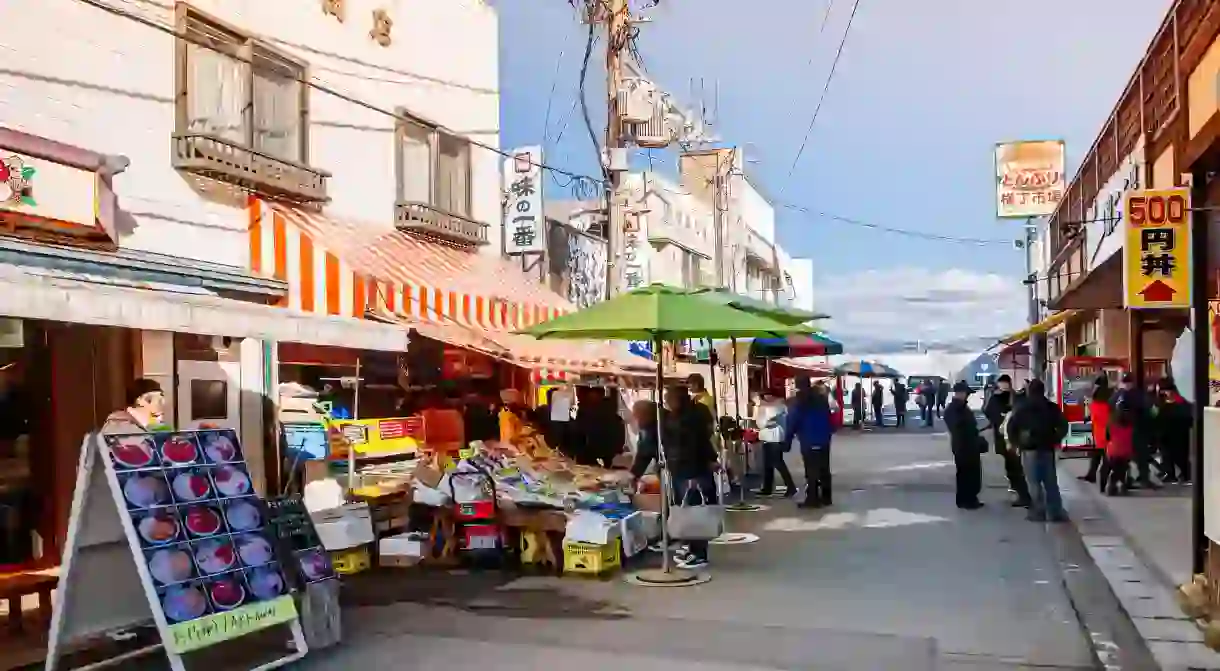A Guide to Souvenir Shopping in Hakodate, Japan

Ever since the first foreign ships sailed into Hakodate harbour in the 1850s, commerce has made this port city tick. Former warehouses on the waterfront are now home to workshops and souvenir stores – offering a great introduction to the vibrant retail scene in this southern Hokkaido city.
Though Hakodate isn’t crowded with modern malls, the best shopping experiences are found among the red bricks of those harbourside warehouses – take the icy racks of squid in the must-see morning market, and the swirls of ice cream in Goryōkaku Tower looming over the city’s landmark star-shaped citadel. Throw locally made leather goods, rabbit-clad homewares and vacuum-packed squid into your shopping basket – these are the best places to pick up a souvenir in Hakodate, Japan.
Hakodate Morning Market
Market, Seafood
The first stop on this shopping guide is many locals’ first stop every morning. Next door to the city’s central railway station, Hakodate Morning Market (Asaichi in Japanese) houses 250 stalls serving ocean-fresh seafood from dawn until noon every day. Hakodate is surrounded by an ocean that’s both rich in plankton and freezing cold, making the local fish extra fatty (and delicious). Peruse the tanks of hairy crabs, trays lined with salmon and tuna, grills sizzling with scallops and baths swimming with squid that visitors can catch themselves before a chef slices it up, sashimi-style, drizzling soy sauce over the meat to make it wriggle. Don’t be scared of eating seafood for breakfast – the Donburi Yokocho Market near the entrance dishes up bowls of rice topped with everything from sea urchin to salmon roe and signature squid, as well as hairy crab steamed buns and vacuum-packed ikameshi (squid stuffed with rice) to take home.
Red Brick Warehouse
Shopping Mall
Western-style red-brick warehouses sprung up along the Hakodate harbourfront in the 1860s, soon after the city became one of northern Japan’s most important trading ports. Today’s traders now occupy these time capsules of the Meiji era. The main two shopping centres are Kanemori and Bay Hakodate. Bay Hakodate’s 17 shops and eateries surround the Bell of Fortune, while Kanemori’s 23 stores sell apparel and accessories under the same gable roof as the Yobutsukan art gallery and Kanemori Brick Labo, southern Hokkaido’s answer to Lego.
Hakodate Meijikan
Shopping Mall
Another red-brick masterpiece – Hakodate’s old central post office, built in 1911 – has also been converted into an industrial-chic shopping mall just steps from the water. A European structure blanketed in vines, it houses a string of souvenir shops behind its tall arched windows. This is a good spot to pick up an example of southern Hokkaido folk art and glassware, join in a workshop to make a DIY music box or rent a kimono and dress-up for some selfies. You can even procure a souvenir here – choose from samurai swords, candy, costumes, cheesecakes made of Hokkaido’s fabled dairy, traditional Japanese dolls, and whatever else can be fitted into a suitcase. All that shopping is hungry work, and the Red Brick Warehouse precinct also features some of Hakodate’s favourite foodie destinations. An Asijai outlet serves the city’s famous shio (salt) ramen, the Hakodate Beer Hall pours house-brewed pints, southern Hokkaido specialty Lucky Pierrot grills its legendary Chinese chicken burger, and Pastry Snaffles plates up fluffy-as-a-cloud cheesecakes.
Ozio
Shop
On the slopes of Motomachi, in the shadow of Mount Hakodate, is where international merchants built their lives after arriving here in the 19th century. In the new millennium, the neighbourhood has become a colourful collection of Christian churches, ice-cream parlours and chic boutiques. Hakodate-born designer Yasunori Nagamine helms Ozio, a high-end leather label producing beautiful bags, wallets and other accessories. Loft is loaded with big-name brands imported from the USA. Carl Raymon is the city’s most mouth-watering butcher, while Yamayoshi and Oshio Coffee are two of Hakodate’s top cafés. But the tastiest corner of the European quarter is Minatogaoka Street, better known as Soft Serve Street, a nickname that comes from the string of ice-cream makers selling Hokkaido milk, as well as local ingredients such as melon and squid ink. Yep, squid ink soft-serve.
Goryōkaku Tower
Architectural Landmark
The 107m (351ft) Goryōkaku Tower contains an observation deck near the top that offers a bird’s-eye view over Hakodate’s star-shaped fort, a vista that’s particularly impressive when the cherry blossoms bloom in spring, or the moat freezes in winter. But that vantage point isn’t the only reason to scale this spire. Stores are spread up and down the tower, including local favourite Kita-usagi, whose rabbit-themed homewares cover everything from pillows and plates to cutlery and playing cards. Souvenir stores also sell take-home vacuum packs of curry to make Hakodate’s much-loved soup, tokens of warrior Toshizo Hijikata and the fort’s bloody Battle of Hakodate, and swirls of Hokkaido’s beloved soft-serve ice cream. Don’t miss the Rokkatei dessert shop near the bottom of the tower. Elsewhere, the airport, JR station, ferry terminal and gift store at the ropeway station beneath Mount Hakodate are other good places to pick up little knick-knacks and sweets.
Kiralis Hakodate
Shopping Mall
Most international visitors stick to the tourist-friendly shopping spots listed above, but Hakodate has a handful of everyday malls as well. Just outside the east exit of Hakodate station, Kiralis Hakodate houses the Hakodate Food Port, the Ezolis souvenir store and other retailers across the first five floors of this glistening new tower. Next door to Goryokaku-Koen-Mae Station, Share Star Hakodate houses a food court dubbed Siesta Kitchen, a flagship Muji outlet and another Ozio boutique. And north of the city centre next to Goryōkaku Station, the open-air Pole Star Shopping Center contains 40-odd stores across two floors. Retail fix sorted.













